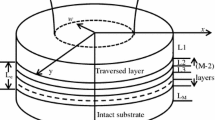Abstract
Ion implantation of boron is used to create n on p photodiodes in vacancy-doped mercury cadmium telluride (MC.T). The junction is formed by Hg interstitials from the implant damage region diffusing into the MC.T and annihilating Hg vacancies. The resultant doping profile is n+/n-/p, where the n+ region is near the surface and roughly coincides with the implant damage, the n- region is where Hg vacancies have been annihilated revealing a residual grown-in donor, and the p region remains doped by Hg vacancy double acceptors. We have recently developed a new process modeling tool for simulating junction formation in MC.T by ion implantation. The interstitial source in the damage region is represented by stored interstitials whose distribution depends on the implant dose. These interstitials are released into the bulk at a constant, user defined rate. Once released, they diffuse away from the damage region and annihilate any Hg vacancies they encounter. In this paper, we present results of simulations using this tool and show how it can be used to quantitatively analyze the effects of variations in processing conditions, including implant dose, annealing temperature, and doping background.
Similar content being viewed by others
References
J. Meléndez and C.R. Helms,J. Electron. Mater. 22, 999 (1993).
J. Meléndez and C.R. Helms,J. Electron. Mater. 24, 565 (1995).
J. Meléndez and C.R. Helms,J. Electron. Mater. 24, 573 (1995).
C.R. Helms, J.L. Meléndez, H.G. Robinson, S. Holander, J. Hasan and S. Halapete,J. Electron. Mater. 24, 1137 (1995).
L.O. Bubulac, W.E. Tennant, D.S. Lo, D.D. Edwall, J.C. Robinson, J.S. Chen and G. Bostrup,J. Vac. Sci. and Technol. A 5, 3166 (1987).
G. Destefanis,Nuclear Instruments and Methods 83, 567 (1983).
R. Kumar, M.B. Dutt, R. Nath, R. Chander and S.C. Gupta,J. Appl. Phys. 68, 5564 (1990).
H. Schaake,J. Vac. Sci. Technol. 4, 2174 (1986).
N.E.B. Cowern, K.T.F. Janssenand, H.F.F. Jos,J.Appl. Phys. 68, 6191 (1990).
D.J. Eaglesham, P.A. Stolk, H.-J. Gossmann and J.M. Poate,Appl. Phys. Lett. 65, 2305 (1994).
H.G. Robinson, M.D. Deal, G. Amarantunga, P.B. Griffin, D.A. Stevenson and J.D. Plummer,J. Appl. Phys. 71, 2615 (1992).
J.C. Hu, M.D. Deal and J.D. Plummer,J. Appl. Phys. 78, 1606 (1995).
J.P. Biersack and L.G. Haggmark,Nucl. Inst. andMeth. 174, 257 (1980).
J.F. Ziegler, J.P. Biersack and U. Littmark,Stopping Powers and Ranges of Ions in Solids (New York: Peragamon Press, 1985).
K.S. Jones, S. Prussin and E.R. Weber,Appl. Phys. A 45, 1 (1988).
Author information
Authors and Affiliations
Rights and permissions
About this article
Cite this article
Robinson, H.G., Mao, D.H., Williams, B.L. et al. Modeling ion implantation of HgCdTe. J. Electron. Mater. 25, 1336–1340 (1996). https://doi.org/10.1007/BF02655029
Received:
Revised:
Issue Date:
DOI: https://doi.org/10.1007/BF02655029




